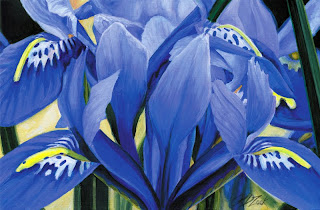
A friend I know in real life posted on Facebook that she was going to start painting again after a long hiatus. Glass had been her medium of choice for years and she was experiencing some trepidation about returning to painting. Most responses indicated not to worry...everything you do is great. Personally, I wouldn't find that very helpful. If you jump into it waving your paintbrush around like Harry Potter with his wand expecting some magical connection between your brain and brush, you're just going to end up turning yourself into a toad and wondering how things went so terribly wrong. Clear the cobwebs first and don't get disappointed if the first few forays aren't quite perfect. I went through this firsthand.
When I first started painting again after nearly 7 years of not painting, I was somewhat terrified. Questions plagued me. Can I still do this? What medium should I use? How big? How small? What style? What subject? What if I fail?
That was the real fear…what if I fail. I think my personal identity had become so entangled with my artistic skill that if I failed, who would I be? No matter what subject I became interested in as a kid, I was always still an artist whether I realized it or not. I wanted to be a marine biologist, so I read books by Jacques Cousteau and drew dolphins and whales. I wanted to be a veterinarian and drew all kinds of animals. I wanted to be an archeologist or anthropologist, so I drew hieroglyphics that I saw at the King Tut exhibit or drew the evolutionary stages of man. I loved the science, still do, but I loved drawing and painting more.
I had continued to work as a graphic designer or freelance illustrator, so it wasn’t as if I had stepped away from art all together, but staring at a blank canvas was not the same to me as staring at a blank computer screen with a given set of elements to work with…the product, the copy, the marketing goal. The blank canvas allowed for an infinite number of choices. Choices that were all mine to make. Making the wrong choice terrified me. You might be thinking, “there aren’t any wrong choices in art,” I wouldn't agree and in my mind every mistake is permanent, non-erasable. When I have made a mistake, I beat myself up more than anyone else ever could.
I think much of my problem was that I always knew who I was. I never HAD to explore or try new things to figure out what I wanted to do. I had never really floundered in any part of my life. I had never spectacularly failed at anything. A painting professor I had in college told me that most of his students were like sponges, trying out all the styles or suggestions he offered, but I wasn’t. I integrated into my work what I thought fit and disregarded the rest. He was neither complimenting me or criticizing me, merely pointing out a characteristic I wasn’t consciously aware of. I really hadn’t been aware of this trait in myself and I think I missed out on new discoveries or personal revelations because of it.
I did finally choose a medium, realized that I hated canvas and preferred to paint on hard board, and decided not to limit myself to one particular subject. The fear of failure still hovers above me. It’s just part of my nature, I can never really banish it. I have discovered that the paintings I wanted to throw in the lake at some point during their creation are usually the ones people respond to the most. It seems that the more I push myself and do struggle the stronger the result.
I have learned more about myself through my art. Setting up a challenge and working through the struggle is how to grow as an artist and as a person. I try not to become complacent or paralyzed by fear. I’m learning to take chances. My art is still completely tangled up in how I perceive myself, but I think I like it that way.
About the Painting:
"Mini Iris 2"
Acrylic on Board
6" x 4"
note: dimensions are unframed size-comes mounted in black floater frame
$175.00
These miniature irises are blooming in my garden right now. The first sign that spring is on its way.


